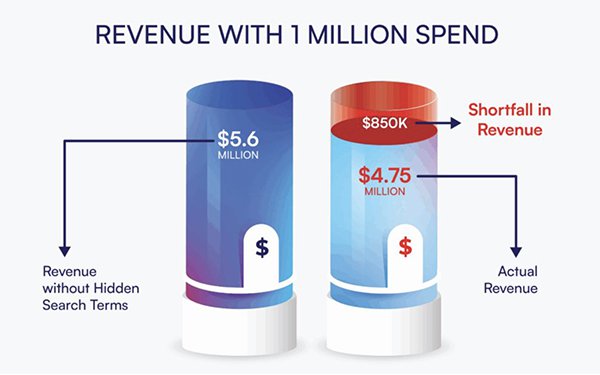
Google scrapes profit from advertisers through the heavy use of hidden
search terms, as advertisers continue to see percentages of visibility in search queries decline.
Recent independent data suggests that 26.7% of search spend and 33.5% of shopping spend is now
hidden, but visibility does vary. Among the accounts analyzed by Collin Slattery, founder at Taikun Digital, the lowest hidden percentage had only 12.6% of their keyword volume hidden, whereas the
highest had 73.3% hidden.
His data suggests that 26.7% of search spend and 33.5% of shopping spend is now hidden.
This means advertisers cannot see the specific search queries
that triggered their ads or the specific products that led to purchases. This "hidden" data is a result of Google reducing the amount of search query data available to advertisers, purportedly
for privacy reasons.
advertisement
advertisement
Slattery analyzed $20 million in ad spend and 14 million clicks across 933 campaigns — about 779 search campaigns and 154 shopping campaigns. The campaigns
were categorized and analyzed to mine them for insights.
With the knowledge to dig into the nuances of paid search and social, and landing page services for small and mid-sized businesses,
Slattery discovered that hidden search terms do waste money to “a staggering degree.”
Among the accounts it serves, the lowest hidden percentage had only 12.6% of their keyword
volume hidden, whereas the highest had 73.3%.
“We expected to see visible outperform hidden as this is something that, anecdotally, everyone who works with Google ads has seen,” he
wrote in a blog post. “The size of the delta between the two, however, (5.60x for visible and 2.59x for hidden) was even larger than I was expecting.”
For all the findings in
Taikun’s dataset, visible search terms performed more than two times better than hidden search terms. This means that 28% of ad spend in the sample performs half as well as the other 72%.
He expected to see higher CPCs for hidden search terms. The main benefit to Google in hiding search terms is it “severely restricts the ability of advertisers to opt out of the
auction,” which increases the number of advertisers competing in the auction for these search terms, even if they don’t want to do so.
It also increases the CPCs and as a result,
the visible CPCs are $1.24 and hidden CPCs are $1.88, he wrote.
“What’s hiding in those elevated CPCs is increased profit for Google by monetizing search queries that would not be
receiving this level of auction competition otherwise,” he explained. “The difference between the two is stark with visible search terms earning a CTR of 3.78% on average and hidden terms
earning just a 2.13% CTR.”
But a lower CTR and a higher CPC explains low quality terms with forced bidding based on nearly 3,000,000 hidden clicks, too.
The most unexpected data
from this project points to nonbrand search and shopping, the average return on ad spend (ROAS) between visible and hidden terms was close. The average visible ROAS for nonbrand was 1.90x and 1.88x
for hidden.
Slattery explained in the blog post how it’s driven in large part by nonbrand shopping ads—22.7% of all nonbrand spend went to shopping—which saw a higher ROAS
for hidden search terms than visible search terms at 2.64 vs 2.51.
The data also shows that the delta between hidden and visible search terms is greater with Search than with Shopping. It is
also larger between brand vs. nonbrand.
It is interesting to see that brand spend accounted for 33.63% of the total spend across the company’s dataset. Of that spend, hidden terms had a
ROAS 57% lower, a conversion rate 35% lower, a CTR 61% lower, and a CPC 99% higher.
The hidden brand CPC of $1.53 is closer to the hidden nonbrand CPC of $1.83 than it is to the visible brand
CPC, he wrote. Hidden search terms spent $1.3 million -- which represented a forced revenue inefficiency of $8.7 million
‘Match types are nearly meaningless with even exact match
frequently matching to hundreds of different queries, so it feels like there’s nonbrand queries in the hidden search terms on brand campaigns,” Slattery wrote.
What makes this data
interesting is the acknowledgment of Ginny Marvin, Google Ads product liaison, in Slattery’s LinkedIn post.
“This was something I asked about when joining Google,”
Marvin wrote. “What I learned: the threshold increase was solely privacy-driven. A search term is reported when it meets sufficient search volume across all Google searches. The threshold
applies to all queries.”
Marvin explained there’s always a tradeoff between volume and marginal return on ad spend, she wrote. “Our goal is to hit your bidding target.
Queries are matched when predicted to help achieve your desired ROI, regardless if they meet reporting thresholds.”
Margin went on to explain how performance isn't “homogeneous
within a campaign or bidding portfolio,” and helpful to see the analysis found little variance in non-brand campaigns when segmented by visible vs. other.
“The variance in brand is
something we can look at more closely, but segmenting by other dimensions may provide more insight,” she wrote. “We'll continue to seek ways to improve visibility in privacy-safe ways. And
we're looking to achieve more consistent ROI across traffic segments.”